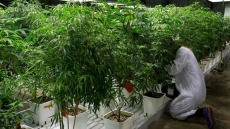OTTAWA - Oxidized copper is no longer the only cause of green rooftops around Parliament Hill.
The parliamentary precinct got its first live green roof last week.
Hundreds of sprigs of stonecrop, a low-growing, low-maintenance ground cover, were planted on the roof of the newly constructed annex to the Sir John A. Macdonald building, just across Wellington Street from the Hill.
And there'll be more rooftop greenery planted atop the historic Wellington Building — once extensive renovations are completed.
The two buildings are harbingers of the growing trend towards sustainable architecture, a trend even the Harper government, often criticized for its lack of environmental sensitivity, has evidently found irresistible.
Until now, there were only six federally-owned buildings across the country with green roofs — including the C.D. Howe Building in Ottawa, which is just outside the parliamentary precinct.
"Green roofs reflect a general trend in green or sustainable architecture," says Sebastien Bois, spokesman for Public Works and Government Services Canada.
"They serve several purposes for buildings, including absorbing rainwater, providing insulation and saving energy — while helping to lower urban air temperatures."
Green roofs can also save energy, improve air quality and reduce emissions of greenhouse gases and sulphur dioxide, according to Public Works.
Workers could be seen last week planting and watering various varieties of stonecrop in rich soil spread over the roof of the annex, a new structure squeezed between the National Press Building and the old Bank of Montreal, which has been rechristened the Sir. John A. Macdonald building.
Once established, Bois said the plants will require minimal water, needing no sprinkler or irrigation system.
The annex was specially designed to accommodate the roof garden, equipped with a waterproof membrane, special insulation, a leak detection system and a drainage system, Bois said.
A few doors to the west, the Wellington Building is intended to be a model of environmental sustainability, not just green on top but inside as well.
Plans for the rehabilitated heritage site include five "green walls," made of living plant matter and designed to help absorb carbon dioxide, dampen noise and clean the air.
In addition to plants on the roof, plans call for the installation of solar panels.
Moreover, the building is to include an "air recovery" system that recycles heat from within the building and uses it to heat incoming air or water.





